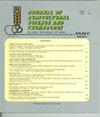草豆遗传多样性的解读农艺和牧草品质性状及SSR标记的收集
IF 1.3
4区 农林科学
Q2 AGRICULTURE, MULTIDISCIPLINARY
引用次数: 0
摘要
草豆(Lathyrus sativus L.)是干旱和饥荒多发地区重要的两用作物,既可作为人类食物,又可作为牲畜饲料和饲料。然而,牧草品质性状的变异在很大程度上仍未被探索。本研究旨在研究来自非洲、亚洲和欧洲的草豆的遗传多样性,并确定具有优良农艺和饲料营养品质性状的基因型。主成分分析表明,营养品质参数(NDF、ADF、纤维素、木质素和灰分百分比)和农艺性状(株高、单株节数、叶面积、绿生物量和干生物量)的前3个主成分占总变异的大部分。11个SSR位点共检测到59个多态性等位基因,平均每个位点有5.36个等位基因,多态性信息含量在0.49 ~ 0.76之间。3个材料(IF1872、IF2177和IF2156)的生物量高于对照,4个材料(IF1327、IF1312、IL-10-76和IF1307)的青草和秸秆营养价值均较好。本研究揭示了草豆生物量和营养品质性状的高遗传变异,为培育高产、营养丰富和两用品种提供了有益的依据。本文章由计算机程序翻译,如有差异,请以英文原文为准。
Deciphering Genetic Diversity in Grass Pea (Lathyrus sativus L.) Collections Using Agronomic and Forage
Quality Traits and SSR Markers
Grass pea ( Lathyrus sativus L.) is an important dual-purpose crop in drought and famine prone areas as it is used as human food as well as livestock feed and fodder. However, the variation for forage quality traits of grass pea remains largely unexplored. This study aimed to characterize the genetic diversity of grass pea collections from Africa, Asia, and Europe, and identify genotypes for superior agronomic and forage nutritional quality traits. The principal component analysis revealed that the first three principal components from nutritional quality parameters viz ., NDF, ADF, cellulose, lignin and ash percent, and from agronomic traits viz ., plant height, nodes per plant, leaf area, green and dry biomass accounted for the majority of the total variation. In addition, a total of 59 polymorphic alleles were detected at 11 SSR loci with an average of 5.36 alleles per locus and the polymorphic information content ranged from 0.49 to 0.76. Three accessions (IF1872, IF2177 and IF2156) with higher biomass than the check and four accessions (IF1327, IF1312, IL-10-76 and IF1307) with excellent nutritive value in both green forage as well as straw were identified. The present study revealed high genetic variation for biomass and nutritional quality traits in grass pea collections that could be useful for development of high-yielding, nutritionally rich, and dual-purpose varieties.
求助全文
通过发布文献求助,成功后即可免费获取论文全文。
去求助
来源期刊

Journal of Agricultural Science and Technology
AGRICULTURE, MULTIDISCIPLINARY-
CiteScore
1.90
自引率
8.30%
发文量
0
审稿时长
4.5 months
期刊介绍:
Journal of Agricultural Science and Technology is one of the TMU Press journals that is published by the responsibility of its Editor-in-Chief and Editorial Board in the determined scopes.
Journal of Agricultural Science and Technology (JAST) is an international research journal published bimonthly for the purpose of advancing the scientific studies. The subjects covered by JAST include all aspects of agriculture and natural resources (see Areas Covered). The journal will consider submissions from all over the world, on research works not being published or submitted for publication towards publication as full paper, review article and research note. The Papers are published in English with an extra abstract in Persian.
 求助内容:
求助内容: 应助结果提醒方式:
应助结果提醒方式:


